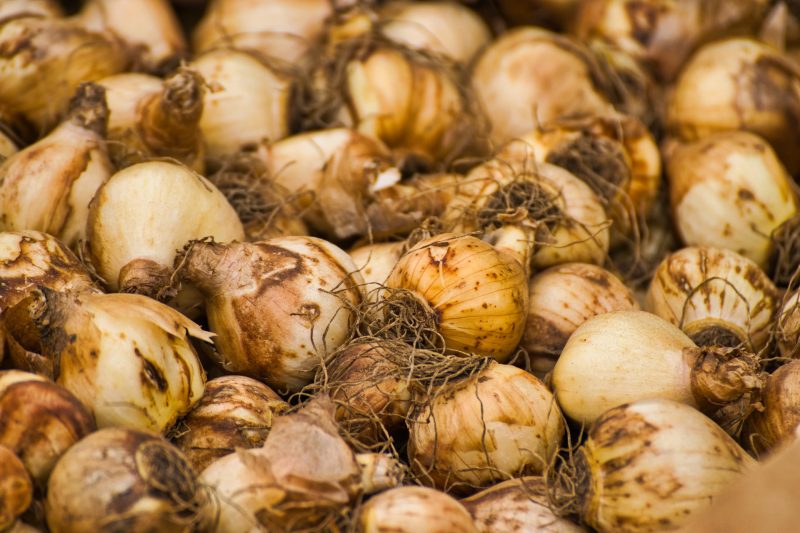If you have bulbs that have been stored for a while, you might be interested to ask: How long do bulbs last unplanted? While seeds can live indefinitely, the same can’t be said for bulbs.
Most bulbs can survive up to a year if you store them properly. How long your bulbs last unplanted depends on how they were stores. Proper storage at the right temperature is necessary to ensure that your bulbs will last a long time. It also depends on the type of bulbs; some may need to be planted right away, while some can be stored for months.

Flower bulbs are generally more delicate, so it’s best to plant them as soon as possible. But tulips, daffodils, crocuses, and other spring-blooming bulbs are one of the toughest bulbs and they can survive unplanted for up to a year.
How to Tell If Your Bulbs Have Gone Bad
Before planting your stored bulbs, you might want to check whether they’re good for planting. Keep in mind that bulbs are still plants, so the chances of them going bad are significantly greater compared to seeds.
Fortunately, it’s not hard to tell if a bulb has gone bad or not. Whether you’ve forgotten that you have bulbs or you’ve had to store them before planting, here’s how you can tell if they’re good to go or not:
Check its firmness
Are your bulbs mushy or firm? Squeeze your bulbs to check its firmness. If they feel mushy, chances are, they’re already rotten. Shrunken or dried bulbs are also an indication that they’ve gone bad.
A healthy bulb should feel plump and firm, and they shouldn’t be too dry or too wet. Your bulbs are likely ready to be planted if they feel firm to the touch.
Check the buoyancy
Another way to find out if your bulbs are good for planting is to check its buoyancy. If your bulbs float on water, it could mean that your bulbs are rotten inside. Internal rotting can cause your bulbs to lose weight; therefore, they can easily float on water. On the contrary, bulbs that sink are most likely healthy and ready to be planted.
Check for mold development
Unplanted bulbs are more susceptible to molding, and once mold develops, it’s better to throw your bulbs away.
Check the smell
Lastly, you need to check how your bulbs smell like. Bulbs usually start to rot inside before it physically shows. If your bulbs smell unusual, the bulbs are likely starting to rot internally and will go bad soon.
How to Store Bulbs Properly
The key to increasing the lifespan of your bulbs is to store them properly. One of the best ways to protect your bulbs is to store them in a cool, dry place with a temperature of at least 50 degrees F. If the weather is warm, you can keep your bulbs in the fridge. When they’re too cold, you can keep them in an unheated garage or basement.
Keep your bulbs in an insulated container or if you don’t have one, a cardboard box will do. But make sure to line them with paper to keep the container dry and ensure that the temperature stays consistent.
Another way to store the bulbs is to mix peat moss and throw the bulbs inside and place them in a cool, dry area. This method is best for summer bulbs since these types of bulbs need a higher temperature when storing them.
You can also choose to place your bulbs in pots and keep them indoors. However, be sure to transfer them to the soil as soon as it gets really cold because the pot may be too cold for your bulbs.
Don’t forget to check the bulbs once every few weeks to ensure they’re still good to go and make sure that the room’s temperature is consistent. If you spot a rotten bulb, throw it out immediately and ensure there’s enough insulation between each bulb.
The Benefits of Growing Your Bulbs in a Mini Greenhouse
Once you’ve decided that your bulbs are ready to be planted, you should consider growing them in a mini greenhouse, and here are some of the reasons why:
Protect your plants from pests
Aphids, mealybugs, cabbage worms, and other harmful insects would like to munch on your flowers and leaves. If you don’t address this problem soon, pest infestation can significantly damage your plants. Placing them inside a mini greenhouse significantly reduces the risk of insects infesting your plants.
Start growing your plants early
Mini greenhouses allow you to start plant growth early – even before the planting seasons starts in your area. Once the weather warms, you’ll be able to replant your plants outside.
Great for keeping your plants safe from bad weather
Lastly, mini greenhouses are useful in keeping tender and delicate plants safe from bad weather. A greenhouse can protect them from frost, ice, and snow during the winter season. And they can also shield them from heavy rains, high winds, and excessive heat. You can choose to transplant your plants outside once the weather gets better.
The Bottom Line: How Long Do Bulbs Last Unplanted?
How long do bulbs last unplanted? When stored properly at the right temperature, your bulbs can last up to a year without being planted. But this long shelf life doesn’t mean you should wait a year before planting your bulbs. The earlier you can plant them, the better the chances of them producing healthy blooms.
